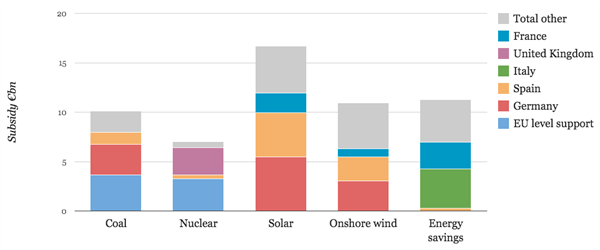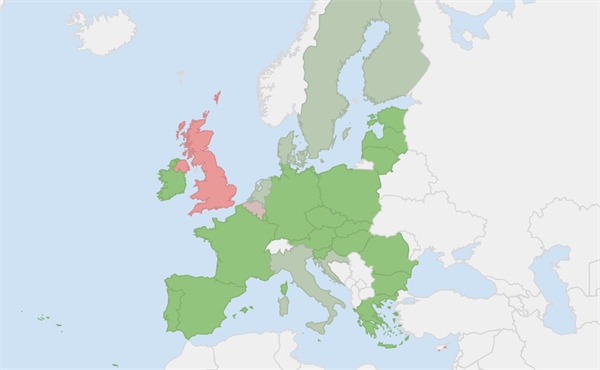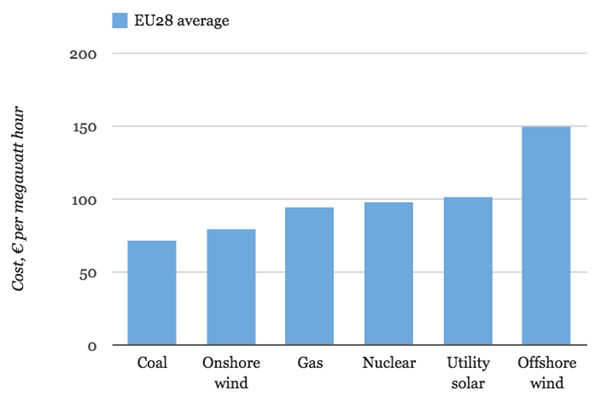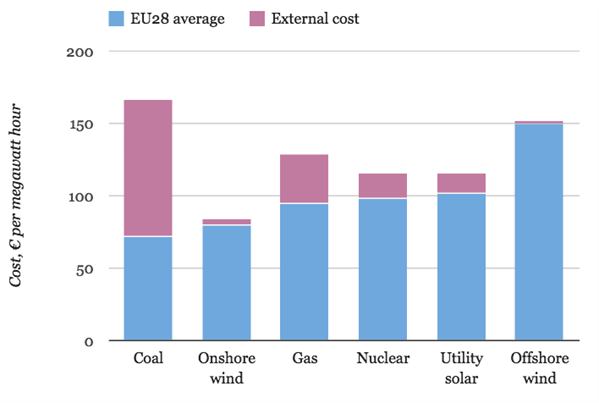The cost of energy tends to dominate arguments about how the world should respond to climate change.
Opponents of strong climate action say that coal is cheap, and government support for renewables is expensive. Green energy advocates say that apparently ‘cheap’ fossil fuels are failing to pay the full costs they impose on society, including health impacts and climate change. There’s an argument about which costs should count, and which shouldn’t.
Getting the right answer really matters. A case in point are the climate and energy targets for 2030 that are due to be agreed by European leaders at a summit next week. Much of their attention will be taken up by whether climate ambition will lead to higher energy costs.
In the lead up to the summit the European Commission has published a detailed study that attempts to tease apart all of the different types of energy cost. The idea is to assess fossil fuels, renewables and nuclear power on a level playing field, including government subsidies and costs not currently priced by the market.
The study contains mountains of information that took a monumental effort by consultants Ecofys to pull together. But it still leaves almost as many questions as answers.
Here are five weird things we learnt from looking at their work, that show how fiendishly difficult it is to assess the true costs of energy.
What is and isn’t a subsidy is pretty complicated
It’s tough to compare subsidies for renewable energy against the ways governments intervene to support other energy sources, like direct financial support, tax incentives, or by taking responsibility for nuclear waste disposal. An annex to the Ecofys report sets out exactly what it has counted as a subsidy (it calls them “public interventions”) and what it hasn’t.
Because almost every study looking at energy subsidies takes a slightly different approach, the Ecofys report shows that how you decide what is a subsidy has a big effect on what kind of results you get.
For instance, Ecofys says Germany doesn’t spend anything at all supporting energy efficiency. That’s despite Germany’s state-backed green bank KfW getting about â?¬1.5 billion per year from the government, which it uses to underwrite the costs of a national energy efficiency programme. Ecofys tells Carbon Brief it didn’t have all the data it needed to include this subsidy in its report.
The UK figures for efficiency also throw up some discrepancies. Spending fell from €640 million in 2009 to €120 million in 2012, Ecofys says. This is in general agreement with other reports showing UK efficiency progress has stalled after recent policy changes.
But the numbers don’t tally with UK government figures, which are a fair bit higher . It’s hard to be sure why there is no overlap, again illustrating just how hard it is to get a clear picture on energy costs and support.
The study also says the UK doesn’t give any subsidies to support oil and gas production. That’s despite increasingly generous ” field allowances” that were worth £1 billion in 2013/14. These allowances reduce the rate of tax paid by some oil and gas fields in the North sea. But they aren’t counted as subsidies by Ecofys because the reduced rate of tax is still above the standard corporate tax rate paid by other industries.
UK nuclear gets more state support than wind
Now let’s take a look at the energy sources that get the highest subsidies. While we do that, it’s important to bear in mind the issues above around gaps in the data, as well as disputes over what counts as a subsidy and what doesn’t.
The commission press release for the study highlighted that renewables received a combined total of €41 billion of support in 2012 compared to €15 billion for fossil fuels and €7 billion for nuclear. This is no surprise given EU efforts to expand renewable generation.
However, that headline figure doesn’t include free allocation of EU emissions trading scheme (EUETS) credits, worth â?¬14 billion in 2012 and down from â?¬38 billion in 2009. All of these free credits amount to additional support for fossil fuel energy, as they allow firms to avoid paying to emit carbon.
We’ve picked out the top four supporters of a range of energy sources in the graph below. This shows that coal received €10 billion in 2012 (far left column), despite major governments having promised to phase out fossil fuel subsidies. Germany (red chunks below) is the biggest supporter of coal by far, giving direct support for hard coal mining. This is due to be phased out by 2018 after pressure from the European Commission.

Source: Annex 2 of the Ecofys energy costs study – graph by Carbon Brief
We asked Ecofys about the EU level support for coal (light blue chunks) but it couldn’t give us any more details. We’re going to guess it relates to funds that were supposed to have been spent on modernising eastern Europe’s energy system but instead supported coal upgrades.
The graph shows that France (dark blue chunks), Spain (orange) and Germany are the biggest supporters of solar power. Italy (green) is the biggest supporter of energy saving, though this should be taken with a pinch of salt, due to the issues we identified above.
The UK (mauve) comes out as the largest supporter of nuclear, way ahead of France despite French reliance on nuclear energy. UK nuclear support of €2.8 billion in 2012 is more than the €1.5 billion Ecofys says the UK government gives to wind.
It thinks UK state support for nuclear amounts to €40 per megawatt hour compared to €50 per megawatt hour for onshore wind – so the figures are comparable even accounting for the amount of energy each produces. The UK plans to give £92.50 per megawatt hour to the Hinkley C new nuclear plant in Somerset that should open in the early 2020s and similar sums to further planned plants.
But it’s worth noting that this UK wind-nuclear comparison is clouded by the fact that Ecofys wasn’t able to separate out money that goes towards dealing with the legacy of the UK’s military nuclear capability.
The UK has the riskiest renewable policy environment
The report averages energy costs across the EU’s 28 member states. Some countries have better prospects for solar because they’re sunny, and some better prospects for wind.
Another factor included by Ecofys when working out these country-to-country cost variations is what it calls a “policy risk premium”. This is the additional cost of financing an investment if there is a risk that government policy might change significantly before a project gets built. A beneficial effect is possible too, where policy certainty makes investment cheaper to finance.
Ecofys thinks that policy certainty made 2012 renewable energy investments three per cent cheaper to finance in twenty EU member states including France or Germany (coloured green in the map, below).

Source: Annex 4 of the Ecofys energy costs study – map by Carbon Brief
Six member states had a neutral policy risk environment (light green). Only two member states had policy environments that would have added risks and costs to renewable investments: Belgium, with a 1.5 per cent risk premium (pink) and the UK, with a 3 per cent risk premium (red).
Ecofys does note that these risk premiums apply to 2008-2012. Since then Italy and Spain have retroactively cut renewable subsidies that were already being received, a step that has significantly dented their attractiveness for investors.
Gas power costs twice as much if it only runs half the time
Given how hard it is to tot up all the money that is already being spent on energy subsidies, it should be no surprise that it is even harder to work out how much energy will cost to produce in future.
Ecofys has had a go, taking into account the costs of building new plant and then operating it and making some assumptions about the future cost of fuel.
The study found that new gas powered electricity would cost €55 per megawatt hour, assuming plants operate at full capacity. That would make gas the cheapest power source. But if a power plant operated only half the time like most plants around the EU today, gas gets more expensive, at €95 per megawatt hour.
Once you take into account the actual amount of time plants will run, coal comes out as the cheapest way to generate electricity, as the chart below shows.

Source: Annex 4 of the Ecofys energy costs study – graph by Carbon Brief
One stunning feature of the graph is the position of solar. At just over €100 per megawatt hour it cost little more than gas or nuclear power as of 2012. That is less than half the 2008 figure, when Ecofys estimated it would have cost around €240 per megawatt hour.
Onshore wind is cheapest if you factor in climate and health
The overall conclusion of the Ecofys study is that meeting the EU’s energy needs in 2012 cost €500 billion. That’s the total cost of production rather than the retail price paid by consumers. That cost doesn’t include paying for the detrimental health impacts caused by power plant pollution, or the cost of increasing the risks of climate change.
The total cost of those additional things that are not yet priced in by the market comes to €200 billion, the report finds. So the true cost of energy is 40 per cent higher. There is a lot of uncertainty in this figure – the extra costs could be as low as €150 billion or as high as €310 billion, which would mean energy should cost 60 per cent more.
What isn’t uncertain is that the vast majority of those climate and health costs – over 90 per cent – belong to fossil fuel energy sources like coal and gas. If you factor in those additional costs, coal is no longer the cheapest form of energy.

Source: Annex 4 of the Ecofys energy costs study – graph by Carbon Brief
Coal’s cost including externalities is more than double the market price, at around €167 per megawatt hour, making coal the most expensive major energy source. Under these assumptions onshore wind is the cheapest source of power. Next would come nuclear and large, utility-scale solar parks.
It’s important to remember, however, that those health and climate costs aren’t currently being paid for. For instance the price companies pay to emit carbon dioxide, at around €6 per tonne, is still well below the €50 per tonne costs it is thought to impose on society.
If we want our energy system to reflect the full costs it imposes, sorting out the carbon price would be an obvious place to start.

